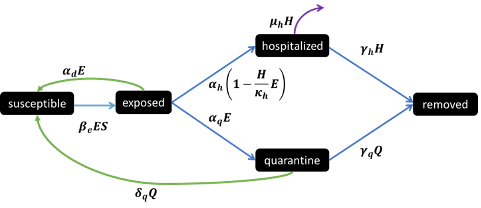VOLUME 15 NUMBER 1 (January to June 2022)

SciEnggJ. 2022 15 (1) 035-046
available online: February 28, 2022
*Corresponding author
Email Address: memata@up.edu.ph
Date received: August 16, 2021
Date revised: November 07, 2021
Date accepted: February 10, 2022
ARTICLE
A modeling strategy for novel pandemics using monitoring data: the case of early COVID-19 pandemic in Northern Mindanao, Philippines
Jayrold P. Arcede1,7, Randy L. Caga-anan2,7, Youcef Mammeri3, Rhoda A.Namoco4,7, Ian Christian A. Gonzales5, Zython Paul Lachica7,8, and May Anne E. Mata*6,7,8
1Department of Mathematics, Caraga State University, Butuan City,
Philippines
2Department of Mathematics and Statistics,
MSU-Iligan Institute of Technology, Iligan City, Philippines
3Laboratoire Amiénois de Mathématique Fondamentale et Appliquée,
CNRS UMR 7352, Universite de Picardie Jules Verne,
80069 Amiens, France
4Department of Applied Mathematics,
University of Science and Technology of Southern Philippines,
Cagayan De Oro, Philippines
5Center for Health Development Northern Mindanao,
Department of Health, Cagayan de Oro City, and Philippines
6Department of Mathematics, Physics and Computer Science,
University of the Philippines Mindanao, Davao City, Philippines
7Center for Applied Modeling, Data Analytics, and Bioinformatics,
for Decision Support System in Health, University of the Philippines
Mindanao, Davao City, Philippines
8University of the Philippines Resilience Institute,
University of the Philippines, Diliman, Diliman, Quezon City, Philippines
Philippines
2Department of Mathematics and Statistics,
MSU-Iligan Institute of Technology, Iligan City, Philippines
3Laboratoire Amiénois de Mathématique Fondamentale et Appliquée,
CNRS UMR 7352, Universite de Picardie Jules Verne,
80069 Amiens, France
4Department of Applied Mathematics,
University of Science and Technology of Southern Philippines,
Cagayan De Oro, Philippines
5Center for Health Development Northern Mindanao,
Department of Health, Cagayan de Oro City, and Philippines
6Department of Mathematics, Physics and Computer Science,
University of the Philippines Mindanao, Davao City, Philippines
7Center for Applied Modeling, Data Analytics, and Bioinformatics,
for Decision Support System in Health, University of the Philippines
Mindanao, Davao City, Philippines
8University of the Philippines Resilience Institute,
University of the Philippines, Diliman, Diliman, Quezon City, Philippines
The COVID-19 pandemic has severely impacted individuals living in developing countries, including the Philippines. Possibly, COVID-19 might not be the last pandemic that can hit the country hard. To provide timely and evidence-based insights for health policymakers to control the spread of a novel infectious disease that might arise in the future, we proposed a mechanistic model that captures the dynamics of an infectious disease during its early phase, when testing capacities are limited. Specifically, we aimed to understand the COVID-19 dynamics during its early phase by formulating a mechanistic model that uses the monitoring data (e.g. number of PUMs, PUIs from Northern Mindanao, Philippines), which are the available information on hand during that time. Closed-form formulas for the basic and effective reproduction numbers of the model were obtained to gain insights on the transmissibility of COVID-19. Sensitivity analysis was done to identify the epidemiological parameters that significantly affect the disease dynamics. We also provided numerical experiments to simulate COVID-19 dynamics. The results showed that the increasing basic reproduction number and disease transmission rate (from the susceptible to exposed population) were highly correlated. With limited testing capacities and unavailability of vaccines during the early phase of the outbreak, the combination of containment, lockdown, social distancing, and amplified efforts to quarantine exposed individuals can reduce the disease transmission rate. We further highlight that monitoring data, when modeled appropriately, can provide insights that can serve as a guide to our policymakers to craft evidence-based health protocols. Consequently, we note to use appropriate models when laboratory-based disease reports (e.g. those cases identified from RT-PCR tests) are available since the model is tailored fit to an early epidemic.
© 2025 SciEnggJ
Philippine-American Academy of Science and Engineering